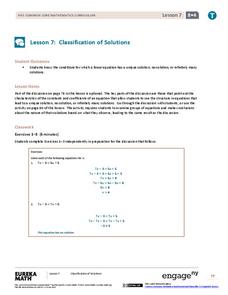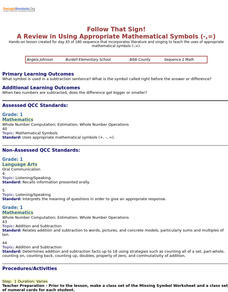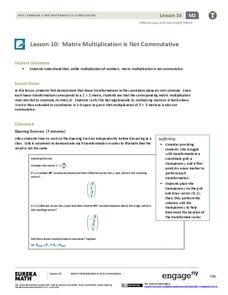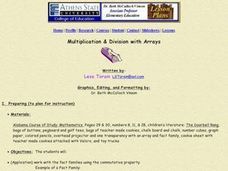EngageNY
The Multiplication of Polynomials
If you can multiply multi-digit integers, you can multiply polynomials. Learners use an area model to compare multiplying numbers to multiplying polynomials. They progress to using the distributive property.
EngageNY
Building Logarithmic Tables
Thank goodness we have calculators to compute logarithms. Pupils use calculators to create logarithmic tables to estimate values and use these tables to discover patterns (properties). The second half of the lesson plan has scholars use...
EngageNY
Solving a Linear Equation
Solving an equation is the art of creating simpler equivalent equations using properties of equality. Here, classes see that solving an equation is not always as easy as guessing. The lesson presents linear equations that scholars must...
EngageNY
Replacing Letters with Numbers II
Teach about properties properly. Individuals investigate the commutative and identity properties for both addition and multiplication. They see that the properties hold true for all values by using substitution to test out several examples.
EngageNY
Numbers Raised to the Zeroth Power
What in the world is the zeroth power? Examine the patterns of exponents as they apply to the zeroth power. Scholars apply the zero property to simple exponential expressions in this fourth lesson in a series of 15. The examples include...
EngageNY
Multiplication of Numbers in Exponential Form
Develop a solid understanding of multiplication and division properties of exponents. Individuals expand exponential terms to discover the patterns and create the properties in the second installment in a series of 15. The activity...
EngageNY
Classification of Solutions
Is there one, none, or more? Through discussion or activity, scholars find the properties of an equation that will determine the number of solutions. They then use the properties discovered to figure out the number of solutions...
Curated OER
Properties of Matrices
A TI-nspire lesson to find determinants of matrices using calculators. The class follows along in this step by step activity to explore operations on matrices. They will mostly be multiplying and at the end of the lesson they are guided...
EngageNY
Factoring Expressions
Factor in an informative resource when teaching about factoring. The 11th activity in a 36-part module shows pupils how to factor algebraic expressions by applying the distributive property. Some of the problems involve expressions with...
National Gallery of Canada
Surprising Sun Prints
Here comes the sun! Composition, shapes, and the properties of light are the focus of this bright lesson. Class members examine art and then create sun prints using photosensitive paper and various objects of different shapes and sizes....
Curated OER
Distributive Property
In this distributive property worksheet, young scholars solve and complete 3 different types of problems. First, they multiply the tens and then, the ones, separately. Finally, they add and write their answer.
Curated OER
Mathematical Properties for Addition
In this math worksheet, students read about and learn the properties of addition. Students study the commutative, associative, identity and inverse properties. There are no problems on this page for students to solve.
Curated OER
Classifying Triangles Based On Properties of Angles
The interactive lesson featured here calls for the use of a Smartboard for sorting and classifying shapes. Then, pupils discuss the rules they followed for sorting their shapes, particularly focusing on the properties of angles. While...
EngageNY
Adding and Subtracting Expressions with Radicals
I can multiply, so why can't I add these radicals? Mathematicians use the distributive property to explain addition of radical expressions. As they learn how to add radicals, they then apply that concept to find the perimeter of...
EngageNY
Solving Equations Using Algebra
Use a tape diagram to emulate the steps of solving equations. The 23rd installment in a 25-part unit presents two-step linear equation problems to solve. Pupils use tape diagrams to solve the problems along with linear equations. To...
EngageNY
If–Then Moves with Integer Number Cards
Pairs with the same sum of integer cards verify the addition and subtraction properties of equality by adding and subtracting like cards to each hand. They also justify the multiplication and division properties of equality using...
Curated OER
Follow That Sign! A Review in Using Appropriate Mathematical Symbols
Kids gain a deeper understanding of mathematical symbols, by playing an interactive game using flash cards. They complete an attached Missing Symbols Worksheet, flash card and an assessment are also included.
EngageNY
Using the Identity and Inverse to Write Equivalent Expressions
The fifth installment in the series of 28 lessons helps math scholars explore the result of adding opposite numbers and multiplying reciprocals. Through this exploration, they develop a working definition of identity and inverse properties.
EngageNY
Matrix Multiplication Is Not Commutative
Should matrices be allowed to commute when they are being multiplied? Learners analyze this question to determine if the commutative property applies to matrices. They connect their exploration to transformations, vectors, and complex...
Curated OER
Identity and Equality Properties: Pages 37-43
In this math worksheet, students use a list of mathematical properties in order to justify their evaluations. Students name multiplicative inverses and properties illustrated in 13 numbers and statements.
Curated OER
Commutative, Associative, and Distributive Properties
Pupils explore the concepts of commutative, associative, and distributive properties. In this beginning algebra lesson, students discuss the terms "commute", "associate", and "distribute" and how they correlate with the related...
Curated OER
Property: Ownership, Respect, and Responsibility
Students learn to respect others' property by rating the severity of a variety of damaging acts. Students use a tag board "thermometer" to rate the severity of statements describing situations where a person damages the property of another.
Curated OER
Limits and Their Properties
High schoolers discuss the following topics of Calculus: The Tangent Line Problem, The Area Problem, and Exercises. They find limits graphically and numerically. Students write a mathematical autobiography, they write their earliest...
Curated OER
Multiplication & Division with Arrays
Third graders work with fact families using the commutative property, arrange arrays with manipulatives, and multiply and divide symbolically with numbers.























